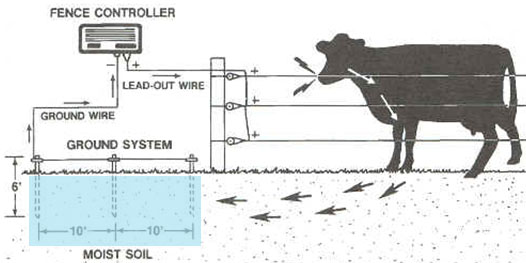This week’s electric fence article from Jason Detzel describes how to set up a Pos/Neg fence to keep it hot even when weeds begin to build up along the bottom wire. It’s a lesson he learned from first-hand experience. You’ll appreciate the diagrams included, as well as the video that shows how to implement it on an electric netting fence.
If you live and work in an arid environment, where soils become drier through the summer, you’ve probably already heard of the Pos/Neg set up. You’ve also probably been told you can solve this problem by keeping the soil around your ground rods damp. The theory is that this provides the moisture necessary for the charge to run from the fence, through the animal to the ground rod, and back through the soil, the animal and back to the fence. That’s a complete circuit. But does damp soil around the ground rods really work?
I don’t know. I’ve done it, and I’ve told others to do it. And I see it shared all over the place as a good solution.
But it doesn’t make sense to me that wet soil around a ground rod would be enough to make up for the all the rest of the very dry soil between the animal and the ground rod. How does the charge travel through that dry soil without any moisture to carry it?

In my years working with fence and livestock, I’ve come across a variety of things folks believe work, but that don’t at all. Is this one of those things?
If you’re an electrician, or a fence expert, please chime in. Or if you have some data, like before and after fence strength showing that moisture around ground rods changed something, do let us all know. I think it would be great if we could clear this up for folks. After all, our portable electric fences are what make so many of us successful. So the more we know, the better off we’ll be.
I’m looking forward to your input!
Thanks for reading!
Kathy
P.S. We’ve already gotten some answers. Check the comments below. 🙂





The best solution for very low soil moisture conditions (which includes frozen soil) is an earth wire return. Have every other wire be a ground wire that connects to the grounding system. If you are installing a new fence, you don’t need insulators on the posts for these wires.
You could do a Pos/Neg or Bi-polar system but only certain energizers can do that.
Use insulated wire for the ground wire where it goes under gateways, don’t direct bury your 12.5 ga fence wire. Even though it technically doesn’t need to be insulated, regular galvanized wire that is direct buried will corrode badly in a few seasons.
Hi Ben!
Sorry to be dense, but could you explain more about the earth return wire? I thought that an earth return and Pos/Neg system were the same thing – where you alternate charged (positive) wires and ground wires (negative). Maybe I used the wrong word for what I thought I was describing in the article.
Thanks for your help!
Kathy
Hi Kathy,
Earth wire return means what I described, a circuit of wires connected to the grounding system. Instead of the shock going from hot wire, through animal, through soil, back to ground rods to complete the circuit, an animal can touch a hot and a ground wire at the same time and get a full shock. You don’t use the term positive and negative with traditional fences and energizers. This is necessary when the ground is frozen or very dry because the circuit is not completed in these conditions with a traditional fence like your diagram. With an earth wire return installation, the ground wire does not need to be insulated on the post which saves some money. If an animal touches only a ground wire on the fence, they don’t get shocked, even if the soil is moist.
With a Bi-polar system (which is specific to Stay-Fix and Speedrite energizers) you have your grounding system hooked to the energizer ground terminal as normal but then you have a terminal for half power and one for full power. One of these is positive and one is negative. You can use either one traditionally and the shock will travel like your diagram. Wire-animal-soil-ground rods.
However, you can wire your fence as two circuits, every other wire + and every other wire -, much like the earth wire return except everything needs to be insulated. One circuit connects to full power terminal, other one connects to half power terminal. This is bi-polar. Animal touches either wire and they get shocked in the same way as your diagram. If they touch a + wire and a – wire at the same time, they get a very intense shock, more than one of the wires independently.
With a traditionally wired fence, like your diagram, it doesn’t matter if two of the wires touch each other.
The downside of the earth wire return, and I believe Bi-polar, is that they require more maintenance. With the earth wire return system, if a hot wire touches a ground wire, you get a very significant short. I believe this is true with a Bi-polar fence where + and – wire touch each other. I have only installed one bi-polar system and didn’t test this. I typically do an earth wire return system for fences with 3 or more wires.
Here is a link with diagrams for all of these types of systems.
https://www.stafix.com/en-us/helpful-information/grounding-your-energizer
A couple of folks have sent me emails with answers to this question.
Donald wrote:
Dry Earth DC Electric Fences have been problematic in the past; but, the Low-Impedance DC Energizers now on the market can be used to complete the “loop” the charge into the “hot” wire must complete back to the DC Energizer. The bottom line—use ALL the grounding opportunities that go back to the DC Energizers Ground Terminal. In my opinion, salted ground rods “to attract moisture” has virtually no benefit, as even a very short distance will eliminate this enhancement and further contribute to corrosion of the ground rods & connections. A clean weed & brush free and maintained “policing” of DC Energized fencing is imperative for a secure barrier!
Larry, who has spent decades building, studying and selling electric fences and equipment says:
The moisture around the ground rods will work ONLY if that moisture flows out to the point on the fence where the animal touches the fence ie a good general rainfall or some type of irrigation. Think of moisture as a continuous ground wire from the energizers ground terminal running out and connecting to the animal.
So their answer is “No, it doesn’t work to keep your ground rods wet if the rest of the soil is to dry to carry the charge.”
Keep in mind ground rods do not have to be at the energizer. We would like the ground rods to reach permanent soil moisture. Often time especially with 110v energizers, the energizer is located where 110v power is available. This is usually where buildings are located, on “high ground” this is the dirt that holds the least amount of moisture for the shortest period of time. If you have a ground wire in your fence the ground terminal on the energizer can be wired directly to the ground wire in the fence. Install the ground rods along the fence line somewhere that has more soil moisture making sure the ground rods are at least 10′ apart. Wire all the ground rods together using min. 12.5 Gauge galvanized wire and galvanized ground rod clamps. Wire from one of the ground rods to the ground wire in the fence that is wired to the ground terminal on the energizer. Single galvanized ground rods should be driven in the ground and connected to the fence ground wire approximately every Km or 3/5 of a mile. Try to pick a site that will hold soil moisture longer. What we are trying to accomplish is limit the distance the electrons have to travel thru dry dirt to get to a ground rod and are put back into a wired system that is connected to the ground terminal on the energizer. There is no substitute for more galvanized iron in the dirt.
Comments are closed.